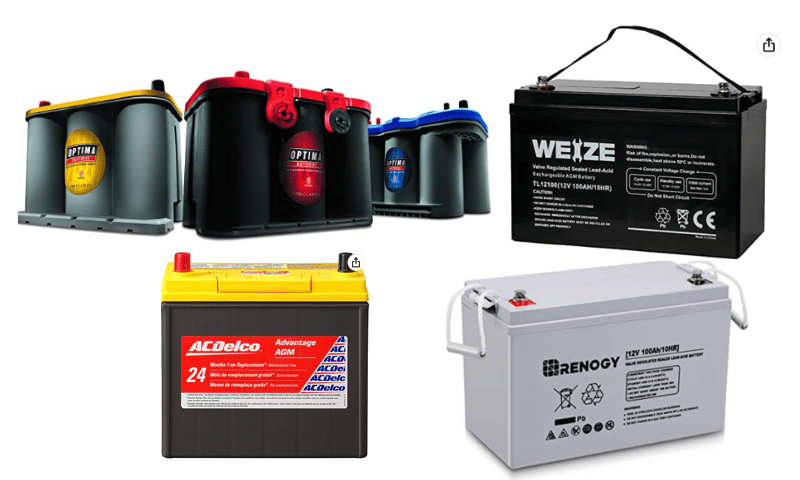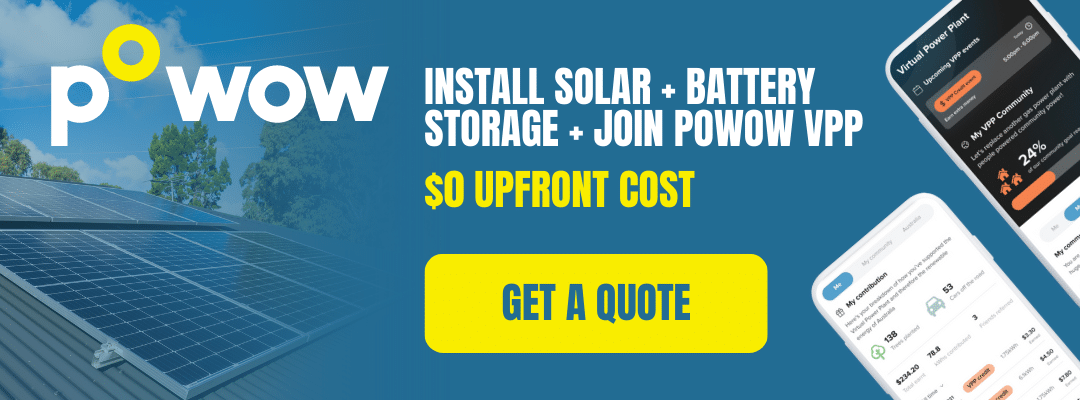
On this page
This guide provides basic information on deep cycle batteries, including the widely used Deep Cycle AGM Battery, some associated terminology, and different chemistry types.
For those seeking more personalised information or considering the integration of deep cycle batteries into their sustainable energy solutions, exploring free solar quotes from Energy Matters could provide valuable insights tailored to your specific needs.
If your main interest is energy storage for grid-connected residential applications in conjunction with solar panels for home in Australia, view our home solar storage batteries guide.
What is deep cycle battery?
In the context of renewable energy, batteries usually refer to deep cycle batteries, such as the Deep Cycle AGM Battery, which are designed specifically for cycling (discharge and recharge) often.
Deep cycle batteries are energy storage units in which a chemical reaction develops voltage and generates electricity. These batteries are designed for cycling (discharge and recharge) often.
A deep cycle battery is a type of battery that is designed to provide a consistent amount of power over an extended period of time. Unlike other types of batteries, such as car batteries or starting batteries, deep cycle batteries are designed to be discharged and recharged repeatedly without damaging the battery. In Australia, deep cycle batteries are commonly used in various applications, including solar power systems, marine applications, and RVs.
There are different types of deep cycle batteries.
Types of deep cycle battery
- Flooded batteries
- Gel batteries
- Sealed lead acid batteries
- AGM deep cycle batteries (Absorbed Glass Mat)
- Lithium-ion
All have different manufacturing processes.
Among conventional deep cycle batteries, the flooded battery is the most common, which is similar to the standard lead acid battery in your car.
As the name suggests, the gel batteries have a gel-like substance, and the AGM deep cycle battery consists of acid suspended in a glass mat separator.
While Flooded, AGM deep cycle batteries and gel batteries are used most frequently in off-grid scenarios, next generation lithium-ion battery systems will experience significant uptake among grid-connected households in Australia – and off-grid too.
Flooded lead acid batteries
Flooded lead acid batteries, or wet cells, are the oldest type of rechargeable battery still in use. This type of battery contains a liquid in an unsealed container. This means that the battery must be upright and in an area with good ventilation to ensure the safe dispersal of the hydrogen gas that the batteries produce during overcharging. The lead-acid battery is also very heavy for its supply of electrical energy.
Flooded lead acid batteries require period monitoring and topping up with distilled water. Despite these disadvantages, flooded batteries have high surge currents, are easier to troubleshoot, and are relatively inexpensive.
Energy Matters has been a leader in the renewable energy industry since 2005 and has helped over 40,000 Australian households in their journey to energy independence.
Let us discuss and choose the best quote that suits your needs and budget, and we can connect you with our trusted local installers, who will provide up to 3 FREE quotes for your home and business solar energy system. Get your free quotes today!
Sealed lead acid batteries
Sealed lead acid batteries are also known as:
- valve regulated lead acid (VRLA) batteries
- recombinant batteries and
- often called maintenance-free lead-acid batteries.
Examples of VRLA batteries are:
- Absorbed glass mat (or AGM)
- Gel cells
The term “seal lead acid battery” is misleading. A sealed battery will be a safety hazard due to overpressure risks if the battery is overcharged.
Therefore, it is important to consider alternatives such as Deep Cycle AGM Batteries, which offer a safer option.
There is always a safety valve present, hence the name valve-regulated. Even the term “valve regulated” does not describe this technology. These are really “recombinant” batteries, such as Deep Cycle AGM Batteries. This means oxygen evolved at the positive will mostly recombine with the hydrogen ready to evolve on the negative, thus preventing water loss. The valve is only a safety feature in case dangerous amounts of hydrogen are produced.
Gel batteries
A gel battery (also known as a “gel cell”) is a sealed, valve regulated lead-acid deep cycle battery with a gel electrolyte. Unlike flooded lead-acid (wet cell) batteries, these batteries do not need to be upright.
Gel cells virtually eliminate evaporation of the electrolyte, spillage (and subsequent corrosion issues) common to the flooded lead acid battery and boast greater resistance to extreme temperatures, shock, and vibration. As a result, they are often ideal for use in automobiles, boats, aircraft, and other motorised vehicles.

AGM deep cycle battery
Absorbent glass mat (AGM), also known as a Deep Cycle AGM Battery, is a class of lead-acid deep cycle batteries in which the electrolyte absorbs into a fibreglass mat. The plates in an AGM deep cycle battery may be flat like a wet cell lead-acid battery or wound in a tight spiral. The internal resistance of the AGM deep cycle battery is lower than traditional cells. They can handle higher temperatures and self-discharge more slowly.
Valve activation
These batteries have a valve that will activate when the battery is recharged at high voltage. Valve activation allows some of the active material to escape, thus decreasing the overall capacity of the battery. The lids /vents typically have gas diffusers built-in that allow the safe dispersal of any excess hydrogen produced during charging. They are maintenance-free. They can orient in any manner, unlike normal lead-acid batteries, which must be upright to avoid acid spills and ensure the plates sit in the electrolyte.
- AGM deep cycle battery is sealed, easy and safe to transport
- They never need topping up with water
- They can be safely mounted inside a boat, car, caravan, motorhome etc.
- AGM deep cycle battery only needs to be vented to the atmosphere. They do not need to be in a sealed box vented to the outside like wet batteries and can mount on their sides or ends if needed.
- Due to their very low internal resistance, AGM deep cycle batteries will fully charge at a lower voltage and accept a much larger charge current. So, when charging from a standard car/truck alternator, these batteries will fully charge and charge quickly in about 3 hours!
- AGM deep cycle battery can discharge deeper than conventional deep cycle battery without major damage.
- AGM deep cycle battery only discharge up to 3% per month. Even after 12 months of sitting idle, they can recharge and return to full service without major damage. A standard deep cycle battery, if treated the same way, will destroy itself. It will no longer hold a good charge.
- AGM deep cycle batteries were originally developed for the military. They are very robust.

Difference between AGM and deep cycle batteries
Deep cycle battery vs AGM
Absorbent glass mats or AGM batteries have replaced the traditional deep cycle or lead acid batteries.
Compared to the deep cycle battery, the AGM battery is more dependable and has better construction. The lead plates and fiberglass matting are tightly packed, making the battery shock and vibration resistant.
The AGM battery is a prominent choice in motorsports because of its toughness and resistance. On the other hand, deep cycle batteries risk being damaged if they are not secured properly.
Is a AGM battery the same as a deep cycle battery?
AGM batteries are not all deep cycles, though. AGM batteries are a popular option for starting batteries and deep cycling since they have a higher depth of discharge (DoD) than normal flooded batteries, which have a DoD of 50%.
Lithium-ion Batteries
Lithium ion batteries are quite different to conventional deep cycle batteries and have sparked a revolution in grid-connected residential energy storage.
We’ve created a separate, more in-depth article on this topic. Check out our home battery storage guide. You can also view our range of next-generation home battery systems.
How do deep cycle batteries work?
Deep cycle batteries work by using a chemical reaction to produce electrical energy. Inside the battery, there are two electrodes – a positive electrode and a negative electrode – that are immersed in an electrolyte solution. The electrolyte solution is typically made up of sulfuric acid and water.
When the battery, such as the Deep Cycle AGM Battery, is connected to a load, such as a motor or an appliance, an electrical current flows from the positive electrode to the negative electrode, providing power to the load. As the battery discharges, the chemical reaction that produces the electrical energy also causes the electrolyte solution to weaken. When the battery is fully discharged, the electrolyte solution is at its weakest point.
To recharge the battery, a charger is used to reverse the chemical reaction and restore the strength of the electrolyte solution. This process is called recharging, typically taking several hours to complete. Once the battery is fully charged, it can be disconnected from the charger and used again to power a load.
Deep cycle batteries are designed to be discharged and recharged repeatedly without damaging the battery. This is because the electrodes and the electrolyte solution are made to withstand the stresses of the charging and discharging process.
Additionally, deep cycle batteries are designed to discharge more slowly than other types of batteries, which means they can provide power for longer periods of time.
In Australia, deep cycle batteries are commonly used in various applications. One of the most common applications is in solar power systems. In a solar power system, deep cycle batteries are used to store energy generated by solar panels during the day for use at night or during periods of low sunlight.
Deep cycle batteries are also commonly used in marine applications, such as for powering electric trolling motors or providing power to lights and appliances on board a boat. In addition, deep cycle batteries are used in RVs to provide power for appliances and other electrical equipment.
Still can’t afford to switch to solar power?
Are you considering getting solar panels but are currently short on funds? You can still invest wisely, and Energy Matters can help you.
Powow and Energy Matters have teamed up to provide our consumers with an alternative to switching to solar power and battery storage. The biggest obstacle to installing solar and battery storage is typically finance. With Powow’s PPA and VPP, our customers will have a $0 upfront option and financial stability in the uncertain energy market.
Get up to 3 obligation-free quotes by getting in touch with us right away. Find out what payment plan options suit your needs and budget!
Check out our page for Powow: Power Purchase Agreement (PPA) and Virtual Power Plant (VPP).
Deep cycle battery ratings
Up until recently, there were two ways batteries were generally rated: volts and amps.
Amp hours (Ah) are the rating capacity available in chemical energy inside a battery that is converted into electrical energy. It also refers to the amount of energy the battery can store, or conversely, it can be seen as the discharge rate, which measures the time it takes to discharge a battery before recharging.
The capacity of the battery reduces if the battery discharges in a shorter period, for instance, over 1 hour. The amp hour capacity reduces by about 50%, and so will the amount of cycles.
Where the battery discharges at a constant current rate over a number of hours, this is referred to as the “C” rating. For example, many small batteries rate at the C20 rate, which means they will deliver their amp hour capacity if discharging over 20 hours. The types of batteries in large stand alone power systems rate at C100, which means that they are designed to discharge over 100 hours or 4 days. This will give you a life span typically of about 15 years.
You can learn about battery voltages and the state of charge here.
More recently, with the advent of the home energy storage revolution, batteries for residential applications are often referred to by their kilowatt-hour (kWh) capacity.
Discharge cycles
Selecting a battery can be confusing. While all will claim to be particularly well suited to energy storage purposes, all deep cycle batteries are not created equal, even within their types, such as AGM deep cycle battery, gel or sealed lead acid.
As a deep cycle, a battery can be quite an investment. You’ll want one that will last the distance.
One of the ways to determine this among conventional types is the cycle rating; that is, how many times it can be discharged and recharged. One of the best benchmarks for this is the IEC 896-2, based on a 100% discharge.
While discharging a battery 100% is not recommended as it will significantly decrease the life of any deep cycle battery, the IEC 896-2 provides a good baseline for drawing comparisons between brand X and Y or even different battery lines from the same manufacturer.
Deep cycle batteries (lead-based), such as those used in off-grid solar power systems, have much thicker lead plates than car batteries to make them last longer. Deep cycle batteries should never really discharge below 20% of their full capacity because internal resistance causes heat and damage when recharging.
Renewable energy systems usually use a low-charge or low voltage warning light or a low-voltage cut-off switch to prevent the type of damage that will shorten the battery’s life.
Battery shelf life will increase by storing them at lower temperatures because the chemical reactions in the batteries are slower. However, batteries must return to room temperature to reach their maximum voltage. Therefore, most deep cycle battery manufacturers do not recommend refrigerating batteries.
While conventional deep cycle battery systems generally require significant oversight, the next generation of energy storage (lithium-ion) features highly automated management systems. Maintenance and monitoring are nil.
How to maintain your deep cycle battery?
Proper maintenance of your deep cycle battery is essential for optimal performance and a long lifespan. By following the tips outlined above, you can help extend the life of your battery and ensure it provides reliable power over extended periods of time. Remember always to follow the manufacturer’s instructions and consult a qualified professional if you have any questions or concerns about caring for your deep cycle battery.
Charge your battery regularly
Deep cycle batteries need to be charged regularly to maintain their charge capacity. Charge your battery after each use and ensure it is fully charged before storing it. Leaving your battery partially discharged for an extended period can cause damage to the battery.
Deep cycle batteries (lead-based), such as those used in off-grid solar power systems, have much thicker lead plates than car batteries to make them last longer. Deep cycle batteries should never really discharge below 20% of their full capacity because internal resistance causes heat and damage when recharging.
Check the water levels
If you have a flooded lead-acid battery, you will need to check the water levels regularly. Ensure the water level is above the plates but below the bottom of the vent wells. Add distilled water if necessary. Be careful not to overfill the battery.
Keep your battery clean
Keep your battery clean and free from dust and debris. Dirt and grime can cause a battery to discharge more quickly. Use a clean, damp cloth to wipe down your battery regularly.
Store your battery properly
If you need to store your battery for an extended period, make sure to store it in a cool, dry place. Avoid storing it in a location where it is exposed to extreme temperatures or direct sunlight. Keep the battery away from flammable materials.
Battery shelf life will increase by storing them at lower temperatures because the chemical reactions in the batteries are slower. However, batteries must return to room temperature to reach their maximum voltage. Therefore, most deep cycle battery manufacturers do not recommend refrigerating batteries.
Avoid over-discharging your battery
Deep cycle batteries are designed to be discharged deeply, but it is essential to avoid over-discharging your battery. When a battery is over-discharged, it can cause permanent damage to the battery, reducing its lifespan. Always monitor the battery’s voltage and recharge it before it reaches a critical level.
Use a suitable charger
Use a suitable charger for your battery type. Using the wrong charger can cause damage to the battery, reducing its lifespan. Always read the manufacturer’s instructions carefully and follow them when charging your battery.
Renewable energy systems usually use a low-charge or low voltage warning light or a low-voltage cut-off switch to prevent the type of damage that will shorten the battery’s life.
While conventional deep cycle battery systems generally require significant oversight, the next generation of energy storage (lithium-ion) features highly automated management systems. Maintenance and monitoring are nil.
Battery safety, explosions and other hazards
A battery explosion is the result of the misuse or malfunction of a battery. Causes can include attempting to recharge a non-rechargeable battery or short circuiting a battery.
Explosions are most likely to occur when a short circuit generates very large currents. In addition, deep cycle batteries can release hydrogen when they experience overcharging. This is due to the electrolysis of the water in the electrolyte. Normally the gas dissipates quickly. However, this gas can ignite by a nearby spark (for example, when removing the jumper cables).
Note: hydrogen gas production isn’t an issue with lithium-ion batteries.
Attempting to charge a deep cycle battery beyond its electrical capacity, i.e. overcharging, can also lead to a battery explosion, leakage, or irreversible damage. It may also cause damage to the components which use the overcharged battery.
When a conventional battery recharges at an excessive rate, an explosive gas mixture of hydrogen and oxygen may be produced faster than it can escape from within the walls of the battery. This can lead to pressure build-up and possibly bursting the battery case.
In extreme cases, the battery acid may spray violently from the casing and cause injury.
Even maintenance-free lead-acid batteries, including deep cycle AGM batteries, may experience explosions if their valves fail or become blocked. As pressure builds up within the battery cells, a short circuit can ignite the hydrogen-oxygen mixture, resulting in severe injury.
To identify such issues, it’s crucial to check for swollen sides or if the battery feels hot to the touch.
Our professional solar installers in Brisbane will assess and determine your energy needs. We customise a solar panel system in Brisbane to fit the roof size of your property, ensuring you receive the most suitable solar panel system for your Brisbane home, meeting to property’s energy requirements.
If you want to learn about solar battery installation in Australia, our solar power and battery storage calculator is simple! Just enter your postcode and average daily power consumption in kWh. The solar calculator will generate performance information and potential savings. We can send this information to 3 trusted local installers in your area to receive obligation-free quotes.

















































